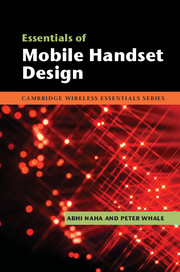6 - Product design
Published online by Cambridge University Press: 05 October 2012
Summary
Introduction
In this chapter, we move the focus away from core handset components, designed to be used in many different handset designs, to the key principles involved in designing a particular handset. Drawing from the best design practice of handset designers who have created commercially and globally successful iconic handsets, two key themes emerge:
applying a holistic design approach;
embedding desirability at the start of the design process.
Holistic design is the integration and blending together of all of the individual design aspects – such as industrial, mechanical, user interface, hardware and software design – in such a way that a balance and synergy is achieved between the different design disciplines. The resulting handset should feel like a complete entity in and of itself, rather than a collection of things “stuck together.”
Desirability is the expression of the needs and desires of the mobile user, encapsulated within the design.
In order to achieve a successful handset design, it is critical to map out the user’s expectations, desires and needs at the beginning of the handset design. Elements of desirability must be injected into the overall handset design along each path of the design flow. This involves everything from choosing the colors and materials of the handset through to the way a user’s finger feels a feedback click on the touchscreen and even to the ambience felt when a customer enters a handset showroom. Mapping this out at the beginning of the design process is important in order to ensure a consistency and adherence to the user expectations and desires throughout the whole design process.
- Type
- Chapter
- Information
- Essentials of Mobile Handset Design , pp. 162 - 194Publisher: Cambridge University PressPrint publication year: 2012

